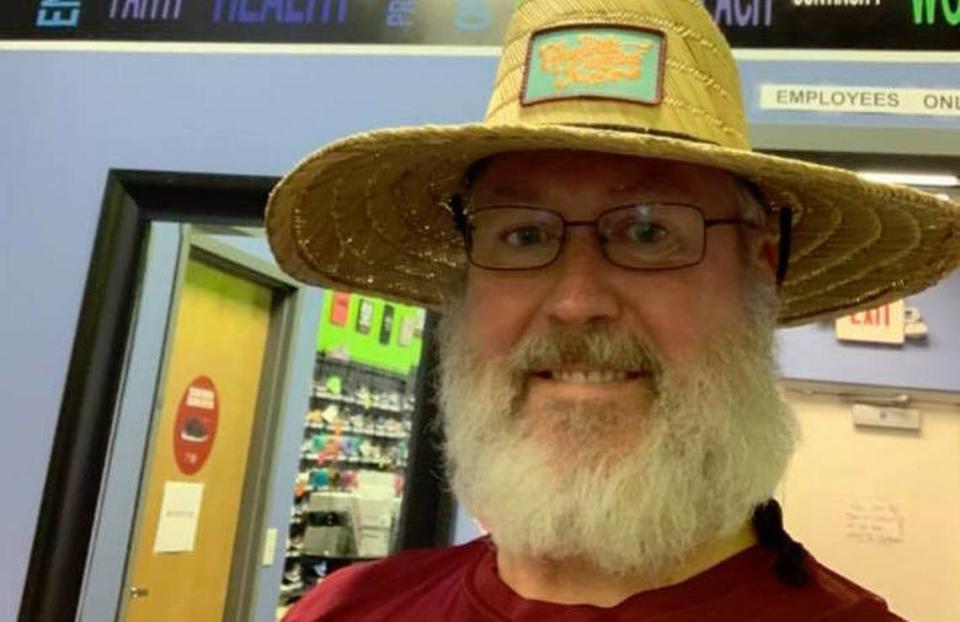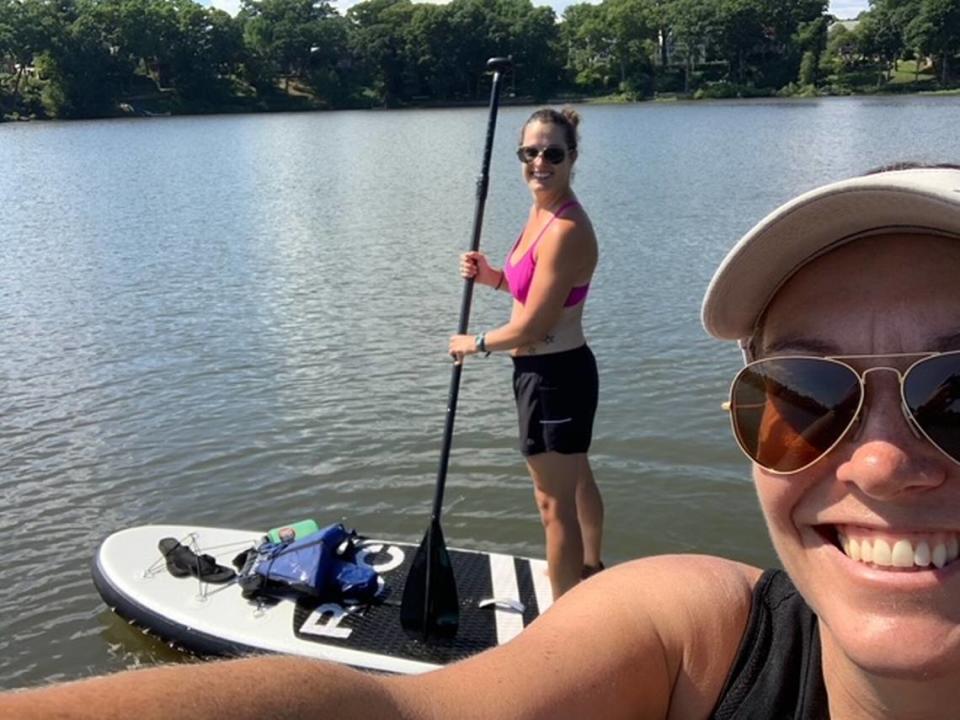Feeling work-from-home fatigue? A fake commute may be just what the doctor ordered.
It’s early morning, well before the birds have risen. It’s still dark, which is Charlotte resident Jana Wood’s favorite time. Finding comfort in the silence, she chooses her commuter bike — one of eight bicycles that she owns — for the morning’s adventure. It’s February, so she’s wearing winter tights and a wool top as she gets on her way, relishing the stillness that accompanies this time of day.
Leaving from her home in NoDa, she glides down neighborhood streets, breathing in fresh air and breathing out whatever thoughts she wants to release on her morning commute. She arrives uptown, her destination for the workday — well, it would have been, were it not for a global pandemic.
But these are COVID-19 times, and so instead of gearing up for a day in the office, Wood catches a glimpse of the sunrise, has a moment alone with Charlotte’s beautiful skyline, watches the Truist Center turn off its lights at 7 a.m. and says hello to a few homeless kittens.
For her next leg, she has chosen a route that allows her to take in the Queen City’s scenery — Cordelia Park, Alexander Street Park, the Blue Line Rail Trail and Optimist Park — for her ride back to NoDa.
Plot twist: Wood’s commute is fake — she works from home during COVID-19.
So how come she’s not rolling straight out of bed and just walking down the hallway to get to work, like the rest of us? Why add in a fake commute?
“I start work and I feel great because I’ve exercised for an hour, and I’m ready to take on whatever,” she said.

Her hour-long bike ride is double her pre-pandemic commute time, and she relishes the time on two wheels.
“It gives me more time to really be aware of my surroundings and gives me the freedom to be able to stop and not be in a hurry because I have to get to work,” said Wood, who is a bike law paralegal.
Without a commute, no time to decompress
A year ago, working from home was a foreign concept to many Charlotte residents. The idea of utilizing the home office or converting the kitchen table into a pseudo work space was far-fetched. Then 2020 happened — insert a global pandemic, COVID-19 protocols, national travel restrictions, state health and safety mandates and a stay-at-home executive order.
Then, what was once odd — commuting from your bedroom to an at-home workspace — is now completely normal.

For Wood, whose primary mode of transportation is cycling, commuting from the bed to a workspace was not a good option. She quickly learned that she had to be intentional about how she spent that time if she wanted to be just as energized and prepared for the workday. Her fake commute does just that. An added benefit is being able to build community with her neighbors.
“I see the same people,” she said. “It’s so funny how people have routines. I see the same guy walking a dog, and I see the same runner. I can see the progress of houses being built in my neighborhood. I can see people putting in fire pits or new lights.”
Leslie Cross, marketing manager of TREK of CLT, also understands the health benefits of a bike commute. Biking combines fun, exercise and the outdoors, she said.

“To me, the best part about biking is that it doesn’t feel like exercise because it is enjoyable,” she said. “Mentally, it does help everybody just to get outside to get moving. You can set things aside while you’re riding and focus on pedaling and looking at the scenery. It’s just a really fun way to get outside and enjoy that.”
Instead of a car dealership, visit a bike shop or running store for your commute
During COVID-19, Cross said that TREK has seen scores of new clients, many of them Charlotteans who are new to biking or haven’t ridden since they were young.
“We’ve had a lot of that this year because of the pandemic sort of forcing people to find alternatives to the gym or whatever their regular workout routine is,” Cross said. “So, it’s been pretty exciting for us.”
Jamie Davis, co-owner of Charlotte Running Co., experienced a surge in business after reopening following the shutdown last March. Davis anticipated the demand because he witnessed the rise of the fake commute in his own neighborhood.

Before the COVID-19 pandemic, Davis’ morning routine already included being out the door by 5:30 a.m. for his morning workout and back in by 7 a.m. to prepare for his workday. These days, he often sees his friends or even runs with them because they have time for it.
“I saw all kinds of people I hadn’t seen in three years that are out walking with their family and pets,” he said. “The amount of people that were getting back into running or walking because they were at home was huge.”
For some Charlotte residents, it may be a little more difficult to surrender their sacred fake commute if and when it’s time to re-enter the office building.
Prior to the start of the pandemic, runner and captain of Black Men Run Charlotte Gregory Washington was never an early riser, which meant evening runs after a long day of work. Now, working from home means waking up at his previous commute start time to run three to five miles before returning to his home office space.

“I really like running in the mornings better,” Washington said. “It’s done, it’s out of the way and you feel better. You’re ready to start the day with a clear mind because running is meditative.”
Separation between home and work
It’s important not to wake up and immediately head straight for the computer, said Maureen Carlomagno, owner and lead coach of Your Wellness Coach in Charlotte.
“When you don’t have a commute, your work and home life blend,” she said. “You can wake up and get in front of the computer and spend that extra hour [from not commuting] working on top of the already eight-hour day.”

Walking is accessible for most people, and being able to get outside and get fresh air and sunshine is good for mental and physical health, Carlomango said.
But it’s February, it’s cold, and there are no rules stating that you even have to leave your house for a “fake commute” — it’s fake, after all. If indoors is calling your name, buy some basic fitness equipment such as a yoga mat, light weights and resistance bands, Carlomagno said. Find an open area in your home and complete an at-home workout before your first meeting.
Even virtual accountability partners are important. For almost a year, Charlotte resident Abby Moore and her friend Jen, who lives in Boston, have spent 30 minutes of Moore’s previous commute time doing virtual workouts such as Zumba, yoga and HIIT five days a week.

“Mentally it really sets me up for the day,” said Moore, who is an associate professor at UNC Charlotte. “It has improved my productivity in that I just feel better and my concentration is better for a longer period of time. It makes me happy. I feel better about myself. I’ve also been able to reestablish this close friendship with Jen.”
Prioritizing during commute time
Does your fake commute have to include exercise?
At the end (or the beginning) of the day, it’s all about setting mindful priorities. Jennifer Webb, Ph.D, director of the integrative positive psychology research lab in mindfulness at UNC Charlotte, said that for her, getting extra sleep, then supporting her son’s virtual learning setup, is the best use of her previous commute time. Their pandemic puppy has been great with helping them engage in physical activity as a family later in the day.

Webb encourages people to take small breaks throughout the day to be present with what’s happening at any given moment.
“We’re sort of being hijacked from one thing to the next, even with being at home,” she said. “Being present and taking a break is important. You’ll be able to refocus and re-energize.”
Tips for starting a fake commute
Webb’s tips for wellness:
Start with 10-20 minutes of activity.
If you want a guided routine, find an app or online service that works for you.
Consider chair yoga, which may also be appropriate for people who would be sitting in their car during their previous commute time.
If you’re sitting a lot, stretch. Stretch in bed in the morning or before you go to sleep.
Take time to focus on breathing and allow your mind to go where it wants to take you.
Try to sprinkle these practices throughout the day, even if it’s just standing and stretching in between meetings or taking a restroom break.
Go for a walk as a family. It’s good for everyone’s mental health.
Cross’ tips for biking:
Find a safe neighborhood to bike around for a quick way to work it into your routine.
Use Traillink to find nearby greenways.
If you’re just starting out, or if you are injured, start with a casual ride on a flat surface and pedal steadily.
Davis’ tips for walking and running:
Decide what you want to get out of the experience.
Utilize a local trail or greenway.
Join a walking or running group to help keep you accountable.
Carlomagno’s general tips for getting started:
Start a routine and remain consistent.
Find pockets of time for your new routine — mornings, lunch or late afternoon.
Set S.M.A.R.T goals (specific, measurable, attainable, relevant and time-based). For example, every Monday, Wednesday and Friday, make a plan to walk for 30 minutes at 4 p.m.
Set alarms to hold yourself accountable and modify as needed.
Work out with the entire family.
Get our newsletter
Sign up now to get CharlotteFive in your inbox daily.

